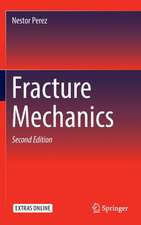Dynamic Fracture
Autor K. Ravi-Chandaren Limba Engleză Hardback – 16 oct 2004
- In-depth coverage of the mechanics, experimental methods, practical applications
- Summary of material response of different materials
- Discussion of unresolved issues in dynamic fracture
Preț: 1504.36 lei
Preț vechi: 2060.76 lei
-27% Nou
Puncte Express: 2257
Preț estimativ în valută:
287.90€ • 297.41$ • 239.60£
287.90€ • 297.41$ • 239.60£
Carte tipărită la comandă
Livrare economică 25 martie-08 aprilie
Preluare comenzi: 021 569.72.76
Specificații
ISBN-13: 9780080443522
ISBN-10: 0080443524
Pagini: 264
Dimensiuni: 165 x 240 x 15 mm
Greutate: 0.62 kg
Editura: ELSEVIER SCIENCE
ISBN-10: 0080443524
Pagini: 264
Dimensiuni: 165 x 240 x 15 mm
Greutate: 0.62 kg
Editura: ELSEVIER SCIENCE
Public țintă
Research and practising engineers in academia and industry in mechanical, structural and civil engineeringCuprins
Contents
Preface
1.Introduction
1.1 Pressurized Thermal Shock in Nuclear Containment Vessels
1.2 Boiler and Pipeline Burst Problems
1.3 Dynamic Fracture in Airplane Structures
1.4 Notched Bar Impact Testing of Metallic Materials
2. Linear Elastodynamics
2.1 Fundamental Boundary-Initial Value Problems in Elastodynamics
2.2 Bulk Waves
2.3 Lame´ Solution
2.4 Plane Waves
2.5 Propagation of Discontinuities: Wavefronts and Rays
2.6 Two-Dimensional Problems in Elastodynamics
2.6.1 Anti-Plane Shear
2.6.2 Plane Strain
2.6.3 Plane Stress
2.7 Surface Waves
2.8 Half-Space Green’s Functions
2.9 Lamb’s Problem
3. Dynamic Crack Tip Fields
3.1 Dynamically Loaded Cracks
3.2 Asymptotic Analysis of Crack Tip Fields
3.2.1 Anti-Plane Shear
3.2.2 In-Plane Symmetric Deformation
3.2.3 In-Plane Antisymmetric Deformation
3.3 Asymptotic Analysis for Nonsteady Crack Growth
3.4 Intersonic Crack Growth
4. Determination of Dynamic Stress Intensity Factors
4.1 Analysis of Stationary Cracks Under Dynamic Loading
4.1.1 Semi-Infinite Crack Under Uniform Loading
4.1.2 Semi-Infinite Crack Under a Point Load
4.2 Analysis of Moving Crack Problems
4.2.1 The Yoffe Problem
4.2.2 Dynamic Stress Intensity Factors for Moving Cracks
5. Energy Balance and Fracture Criteria
5.1 Energy Balance Equation
5.2 Dynamic Failure Criterion
5.3 Dynamic Crack Initiation Toughness
5.4 Dynamic Crack Growth Toughness
5.5 Dynamic Crack Arrest Toughness
5.6 Application of Dynamic Failure Criteria
6. Methods of Generating Dynamic Loading
6.1 Static Loading of Cracks
6.2 Drop-Weight Tower and Instrumented Impact Testing
6.3 Projectile Impact
6.4 Hopkinson Bar Impact Test
6.5 Explosives
6.6 Electromagnetic Loading
7. Measurement of Crack Speed
7.1 Wallner Lines
7.2 Stress Wave Fractography
7.3 Electrical Resistance Methods
7.4 High-Speed Photography
8. Crack Tip Stress and Deformation Field Measurement
8.1 Jones Calculus
8.2 Photoelasticity
8.2.1 Evaluation of the Dynamic Stress Intensity Factor using Photoelasticity
8.3 Method of Caustics
8.3.2 Caustic in Reflection
8.3.3 Mixed-mode Caustics
8.3.4 Limitations on the Applicability of the Method of Caustics
8.4 Lateral Shearing Interferometry
8.4.1 Evaluation of the Dynamic Stress Intensity Factor using Shearing Interferometry
8.5 Strain Gages
8.6 Interferometry References
9. Dominance of the Asymptotic Field
9.1 Stationary Cracks
9.2 Propagating Cracks
9.3 Dominance of the Asymptotic Field for Propagating Cracks
10. Dynamic Fracture Criteria
10.1 Criteria for Crack Initiation
10.1.1 Initiation of Cracks Under Short Duration Stress Pulses
10.1.2 Loading Rate and Temperature Dependence of Crack Initiation Toughness
10.2 Dynamic Crack Arrest Criterion
10.2.1 Development of the Crack Arrest Criterion
10.2.2 ASTM Standard Method for Crack Arrest
10.2.3 Application of the Crack Arrest Criterion
10.3 Dynamic Crack Growth Criterion
10.3.1 Crack Growth Toughness in Nominally Brittle Materials
10.3.2 Crack Growth Toughness in Ductile Materials
11. Physical Aspects of Dynamic Fracture
11.1 Limiting Crack Speed
11.2 Fracture Surface Roughness
11.2.1 Real-Time Observations of Multiple Crack Fronts
11.2.2 Fast Fracture Surfaces in Polymethylmethacrylate
11.2.3 Origin of the Microcracks
11.2.4 Geometry of the Conic Markings
11.2.5 Statistics of Microcracks in PMMA
11.2.6 Growth of Microcracks
11.2.7 Solithane 113
11.2.8 Polycarbonate
11.2.9 Homalite-100
11.3 Crack Branching
12. Phenomenological Models of Dynamic Fracture
12.1 Discrete Models—Molecular Dynamics and Lattice Models
12.2 Cohesive Zone Models
12.3 Continuum Damage Models
References
Further Reading
Appendix A. Dynamic Crack Tip Asymptotic Fields
A1 Dynamic Crack Tip Stress Field for a Stationary Crack
A2 Steady-State Dynamic Crack Tip Stress Field: Singular Term
A3 Steady-State Crack Tip Displacement and Stress Field: N Terms
A4 Transient Crack Tip Displacement and Stress Field: Six Terms
Appendix B. Mechanical and Optical Properties of Selected Materials
Index






